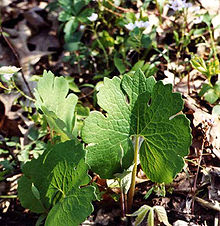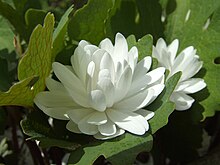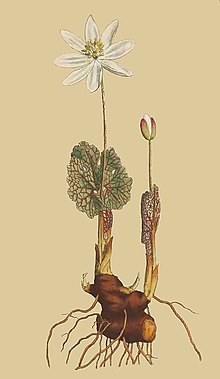Sanguinaria
| Bloodroot | |
|---|---|

| |
| Scientific classification | |
| Kingdom: | |
| Division: | |
| Class: | |
| Order: | |
| Family: | |
| Genus: | Sanguinaria L.
|
| Species: | S. canadensis
|
| Binomial name | |
| Sanguinaria canadensis L.
| |

Bloodroot (Sanguinaria canadensis) is a perennial, herbaceous flowering plant native to eastern North America from Nova Scotia, Canada southward to Florida, United States. It is the only species in the genus Sanguinaria, and is included in the family Papaveraceae and most closely related to Eomecon of eastern Asia.
Bloodroot is also known as bloodwort, red puccoon root, and sometimes pauson. Bloodroot has also been known as tetterwort in America, although that name is used in Britain to refer to Greater Celandine.
Bloodroot is a variable species growing from 20 to 50 cm tall, normally with one large, sheath-like basal multi-lobed leaf up to 12 cm across. The flowers are produced from March to May, with 8-12 delicate white petals and yellow reproductive parts that appear to be clasped by the leaf. Plants can have variable shaped leaves and flowers and have in the past been separated out as different sub species because of these variable shapes, but currently most taxonomic treatments lump these different forms into one highly variable species. Bloodroot stores sap in an underground orange colored rhizome, that grows shallowly under the soil surface and over time can grow into a large colony. Plants start to bloom before the foliage unfolds in early spring and after blooming the leaves expand to their full size and go summer dormant in early/mid summer with the seeds ripening before the foliage as gone dormant. Plants are found growing in moist to dry woods and thickets, often on flood plains and near shores or streams on slopes, they grow less frequently in clearings and meadows or on dunes, and are rarely found in disturbed sites. The flowers are pollinated by small bees and flies, seeds develop in elongated green pods 40 to 60 mm in length. The seeds are round in shape and when ripe are black to orange-red in color. Deer will feed on the plants in early spring.
Caution: the sap is toxic; see below for further details.
Reproduction and genetics
Bloodroot is one of many plants whose seeds are spread by ants, a process called myrmecochory. The seeds have a fleshy organ called an elaiosome that attracts ants. The ants take the seeds to their nest, where they eat the elaiosomes, and put the seeds in their nest debris, where they are protected until they germinate. They also get the added bonus of growing in a medium made richer by the ant nest debris.
 |
 |
 |
 |
The double flowering forms are prized by gardeners for their large showy white flowers, which are produced very early in the gardening season. Bloodroot flower petals are shed with in a day or two of pollination so the flower display is short lived. The double forms bloom much longer than the normal forms, the double flowers are made up of stamens that have been changed into petal looking like parts, making pollination more difficult.
Bloodroot produces morphine-like alkaloids
Bloodroot produces benzylisoquinoline alkaloids, primarily the toxin sanguinarine. The alkaloids are transported to, and stored in, the rhizome.
In comparing the biosynthesis of morphine and sanguinarine, the final intermediate in common is (S)-reticuline.[1][2][3] Plants in families including Papaveraceae, Ranunculaceae, Colchicum, Chondodendron produce such benzylisoquinoline alkaloids.
Plant geneticists have identified and sequenced genes which produce the enzymes required for this production. One enzyme involved is CYP80B1,[4] which produces (S)-3'-hydroxy-N-methylcoclaurine from (S)-N-methylcoclaurine.[5]
Bloodroot extracts are toxic to animal cells
Sanguinarine kills animal cells by blocking the action of Na+/K+-ATPase transmembrane proteins. As a result, applying bloodroot to the skin may destroy tissue and lead to the formation of a large scab, called an eschar. Bloodroot and its extracts are thus considered escharotic.
In spite of supposed curative properties, and historical use by Native Americans as an emetic, extreme caution should be used for any internal use.
On 13 Aug 2005, U.S. news media reported that Dan Raber (of Georgia, United States) came under felony investigation for dispensing bloodroot paste to women with breast cancer. It was reported that nine women developed disfiguring destruction of skin and underlying tissue. Reports also indicated that Lois March, M.D., who is a practicing physician in Cordele, Georgia, has also come under U.S. FDA investigation for her role in prescribing pain medication to Raber's disfigured customers while their use of bloodroot was ongoing[6][7][8]
Commercial uses of sanguinarine extracted from bloodroot
The United States FDA has approved the inclusion of sanguinarine in toothpastes as an antibacterial or anti-plaque agent.[9][10][11][12] Currently, it is believed that this use may cause leukoplakia, a premalignant oral lesion.[13] On 24 Nov 2003, the Colgate-Palmolive Company of Piscataway, New Jersey, United States commented by memorandum (see: PDF file) to the United States Food and Drug Administration that then-proposed rules for levels of sanguinarine in mouthwash and dental wash products were lower than necessary. Professor George T. Gallagher also commented from his post at Boston University Goldman School of Dental Medicine, see his memorandum[1] of 23 June 2003.
Sangrovit® is an animal food additive sold and distributed in Europe. Sangrovit is manufactured by Germany-based Phytobiotics. Sangrovit contains sanguinarine and chelerythrine. On 14 May 2003, Cat Holmes reported in the Georgia Faces[14] that Jim Affolter and Selima Campbell, horticulturists at the University of Georgia College of Agricultural and Environmental Sciences, were meeting with Phytobiotics to relate their research into commercial cultivation of bloodroot.
Historical uses

The plant was used as a dye and for an herbal remedy by the native population. A break in the surface of the plant, especially the roots, reveals a reddish sap.
In physician William Cook's 1869 work The Physiomedical Dispensatory is recorded a chapter on the uses and preparations of bloodroot.[15] Cook described tinctures and extractions, and also included at least the following cautionary reference:
The U. S. Dispensatory says four persons lost their lives at Bellevue Hospital, New York, by drinking largely of blood root tincture in mistake for ardent spirits [...]
Greater Celandine (Chelidonium majus), a member of the poppy family (Papaveraceae) which has, like bloodroot, a caustic, reddish sap, was used in Colonial America as a wart remedy. Bloodroot has been similarly applied in the past. This may explain the multiple American and British definitions of "Tetterwort" in 1913.
See also
References
- ^ http://www.rednova.com/news/health/153716/sanguinarine_biosynthesis_is_associated_with_the_endoplasmic_reticulum_in_cultured/
- ^ http://www.genome.ad.jp/dbget-bin/show_pathway?map00950+1.5.3.12
- ^ http://www.plantphysiol.org/cgi/content/abstract/138/1/173
- ^ http://www.genome.ad.jp/dbget-bin/www_bget?enzyme+1.14.13.71
- ^ http://www.tarweed.com/pgr/PGR00-053.html
- ^ http://www.gwinnettdailypost.com/index.php?s=&url_channel_id=32&url_article_id=5181&url_subchannel_id=&change_well_id=2
- ^ http://www.ajc.com/health/content/shared-auto/healthnews/prss/527423.html
- ^ Composite State Board of Medical Examiners (Georgia) (July 26, 2005). "Accusation against Lois March, M.D."
- ^ http://www.ncbi.nlm.nih.gov/entrez/query.fcgi?cmd=Retrieve&db=PubMed&list_uids=2700895&dopt=Citation
- ^ http://www.ncbi.nlm.nih.gov/entrez/query.fcgi?cmd=Retrieve&db=PubMed&list_uids=6585404&dopt=Abstract
- ^ http://www.cfsan.fda.gov/~dms/coscom99.html
- ^ http://www.ncbi.nlm.nih.gov/entrez/query.fcgi?cmd=Retrieve&db=PubMed&list_uids=2207852&dopt=Citation
- ^ Leukoplakia, (pdf format) hosted by the American Academy of Oral and Maxillofacial Pathology. Page accessed on December 19, 2006.
- ^ http://georgiafaces.caes.uga.edu/getstory.cfm?storyid=1851
- ^ http://www.henriettesherbal.com/eclectic/cook/SANGUINARIA_CANADENSIS.htm
